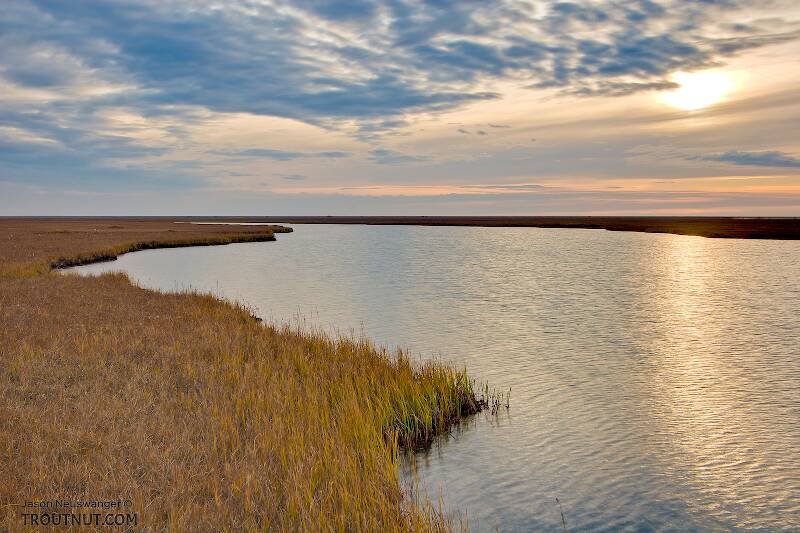
Hex Mayflies
Hexagenia limbata
The famous nocturnal Hex hatch of the Midwest (and a few other lucky locations) stirs to the surface mythically large brown trout that only touch streamers for the rest of the year.

— 4 small yellow spots on frons visible in photos
— Narrow occipital spinule row curves forward (but doesn’t quite meet on stem of ecdysial suture, as it's supposed to in this species)
— Short spinules on anterior margin of front legs
— Short rposterior row of blunt spinules on abdominal tergae, rather than elongated spinules dorsally
I caught several of these mature nymphs in the fishless, tiny headwaters of a creek high in the Wenatchee Mountains.

Mayfly Species Caenis tardata (Angler's Curses)
Species Range
Physical description
Most physical descriptions on Troutnut are direct or slightly edited quotes from the original scientific sources describing or updating the species, although there may be errors in copying them to this website. Such descriptions aren't always definitive, because species often turn out to be more variable than the original describers observed. In some cases, only a single specimen was described! However, they are useful starting points.
Male Spinner
Wing length: 3 mm
A species with short forceps; mesonotum deep brown, head blackish.
Head shaded heavily with blackish; eyes black, antennae pale. Pronotum pale with blackish shading, deepest in the dorsal area; traces of a narrow black line on the posterior margin dorsally, none on the lateral margins. Mesonotum deep brown; faint blackish markings on sutures and lateral margins; black shading on the scutellum. Pleura deep brown; a pale area anterior to the wing root is margined dorsally by a black streak; dark streaks also around the bases of the legs and along the anterior margin of the episternum. Sternum pale, tinged slightly with brown. Fore legs shaded with deep brown at the base; femora smoky, with a darker spot apically; tibiae and tarsi pale. Femora of middle and hind legs pale whitish; black spot on the outer side of each coxa, another at base on the inner side; a fine black dorso-apical streak on each femur, which may be reduced until it is almost invisible. Wings semi-hyaline whitish, subcosta and radius dark.
Abdominal tergites pale yellowish white; broad lateral blackish shading on tergites 1-6, separated by a pale median area; lateral margins pale, no stigmatic dots; posterior margins narrowly dark. Tergites 7 and 8 entirely pale; faint dark shading on 9 and 10, and a tiny median dot on 9. Sternites wholly pale yellowish white, sternite 9 slightly deeper in color, often with a faint smoky transverse streak in the median area near the posterior margin. Forceps and tails pale. Forceps short, rather blunt at the tip (see Pl. XXXIX).
The deep brown mesonotum and the blunt apex of the forceps distinguishes this species from others having short forceps.
Start a Discussion of Caenis tardata
References
- Caucci, Al and Nastasi, Bob. 2004. Hatches II. The Lyons Press.
- Knopp, Malcolm and Robert Cormier. 1997. Mayflies: An Angler's Study of Trout Water Ephemeroptera . The Lyons Press.
- Needham, James G., Jay R. Traver, and Yin-Chi Hsu. 1935. The Biology of Mayflies. Comstock Publishing Company, Inc.
Mayfly Species Caenis tardata (Angler's Curses)
Species Range
Common Names
Resources
- NatureServe
- Integrated Taxonomic Information System
- Global Biodiversity Information Facility
- Described by McDunnough (1931)

